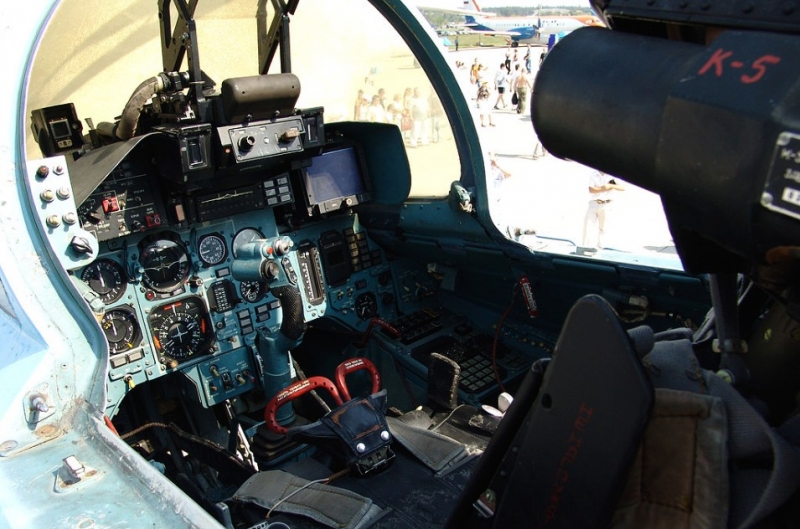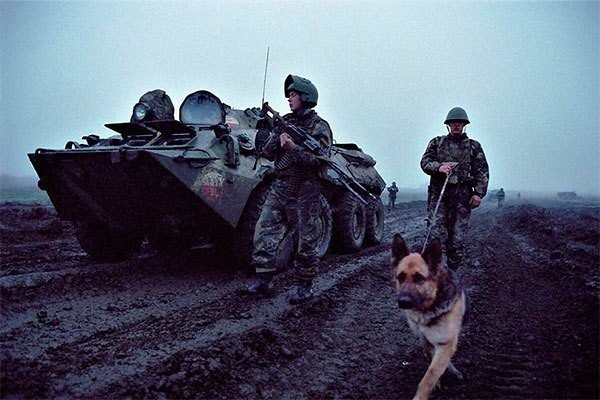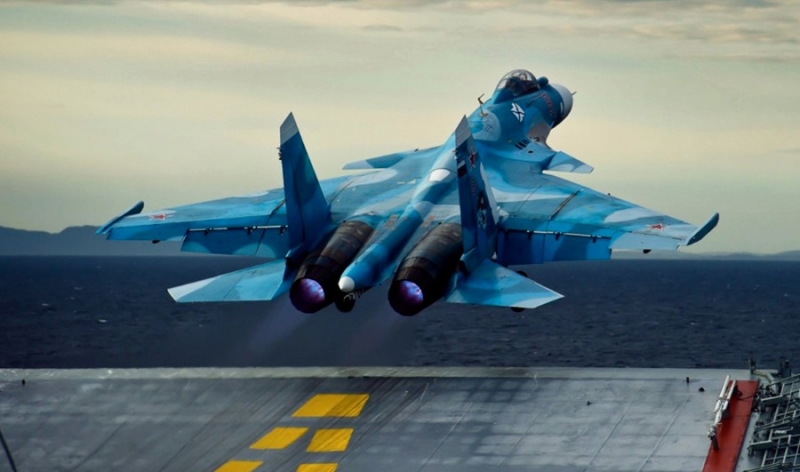
Su-33 (factory code T-10K; formerly known as Cy-27K; NATO codification: Flanker-D) - Soviet / Russian carrier-based fourth-generation fighter, designed for the Russian Navy in the Sukhoi Design Bureau under the leadership of Mikhail Simonov. The first flight of the Su-27K was held 17 August 1987 of the year, a 1 November 1989 Su-27K, the first time in the Soviet Union carried out the takeoff and landing "in the airplane" on the aircraft carrier "Admiral of the Fleet of the Soviet Union Kuznetsov". Adopted 31 August 1998 of the year.
Fighter Su-33 – video
Although the current Russian Navy plans are the construction of new carrier-based aircraft MiG-29K because of their more compact, and the possibility of increasing the wing of an aircraft carrier "Admiral of the Fleet of the Soviet Union Kuznetsov", Su-33 current park, having a large load capacity and range, it is planned to maintain and upgrade: for this in 2016 It was started again the production of engines "AL-31F series 3" for the Su-33, and launched aircraft avionics upgrade to the SVP-24 targeting system. SVP 24 includes a computer-ballistic computer bombing unguided bombs, allowing to achieve accuracy, comparable to the corrected bombs, and provides the pilot collimator sight to attack visually observable goals and LCD screen with a map display to attack targets on the coordinates.
A feature of the Su-33 is the ability to work as a tanker aircraft due to suspended container ORM. In this case, the plane itself is standard equipment for in-flight refueling. ie. The Su-33 can produce ORM refueling and MiG-29K, and second Su-33.
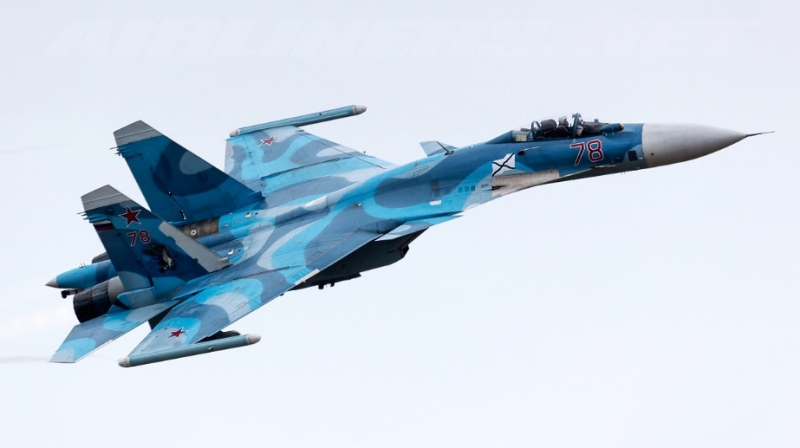
Formation of requirements for the new carrier-based fighter
Fighter Su-33, according to the resolution of 18 April 1984 of the year, It should be developed on the basis of the fourth generation heavy fighter Su-27, which I had already passed the tests and was put into production. The Su-33 was to retain all the advantages and design-layout solutions the basic Su-27. Also, the customer commission, He headed by the commander of naval aviation, Colonel-General Kuznetsov, It was demanded to ensure high efficiency in the performance of tasks to destroy surface targets. Eventually, After completions of conceptual design, in February 1985 the project Su-27K was approved by the Chief of Air Force and Navy of the USSR.
prototypes
AT 1986 year in pilot production Sukhoi began assembling the first prototype, which is not equipped with folding wings and horizontal tail. aircraft assembly was completed in 1987 year, aircraft received the designation T-10K-1 and 17 August of the same year, the first time a car went up in the air, controlled test pilot in. D. Pugachev. During the construction of prototype aircraft all the new parts produced at the pilot plant Dry, also used part of the units of the Su-27 "ordinary", which were delivered to the production KnAAPO. Half a year later to join the second flight tests of the Su-27K, having the designation T-10 K-2, which has already been used folding wings and horizontal tail. The first flight of the second copy is performed 22 December 1987. In summer 1988 , the folding wings and horizontal tail plane was equipped with the first flight pattern, but, 27 September 1988 (a month after the start of its flight tests), the plane crashed due to failure of hydraulic systems.
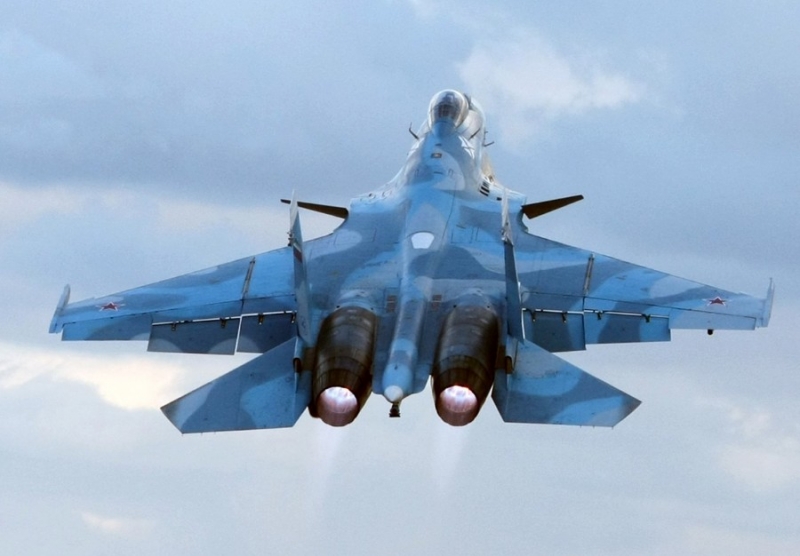
The first landing and taking off from the deck
20 October 1989 years DEUT 'Tbilisi' (now the "Admiral of the Soviet Union Fleet Kuznetsov") first left the Black Sea Shipyard and out to sea. The ship was equipped with is not all radar facilities and missile weapons, but it had all the aviation technical equipment, allowing to carry out the ups, planting and maintenance of aircraft - arrester, starting zaderzhniki, gaz baffling shields, Jets lifts, as well as radio systems landing "Resistor-K42", optical system of planting "Luna-3", CCTV system and the ship's radar.
Exactly a week after, as the aircraft carrier "Tbilisi" was launched, test pilot Viktor Pugachev performed circled at an altitude of aircraft carrier 1500 m, then he took a few laps around his height 30 m above the deck and returned to the airfield Saki. The next week continues test flights of the aircraft carrier Su-33 and MiG-29K, as well as flying laboratories, who performed the testing of radar vehicle systems, working for the carrier-based aircraft. These days, the planes flew over the deck at a height of 2-3 meters, sometimes even touching it, and passing along the entire length, what, actually, It can be called landings, but without the engagement of the arrester. These flights continued until 31 October 1989 of the year, after which it was decided to, and that the plane, and test pilot Viktor Pugachev, and the aircraft carrier itself ready to carry out the first has a "real" landing on the deck. The next day, the first in the history of domestic aircraft landing aircraft usual pattern on the deck of an aircraft carrier. On the same day on the deck of "Tbilisi" made its first landing two more new deck aircraft - MiG-29K and Su-25UTG.
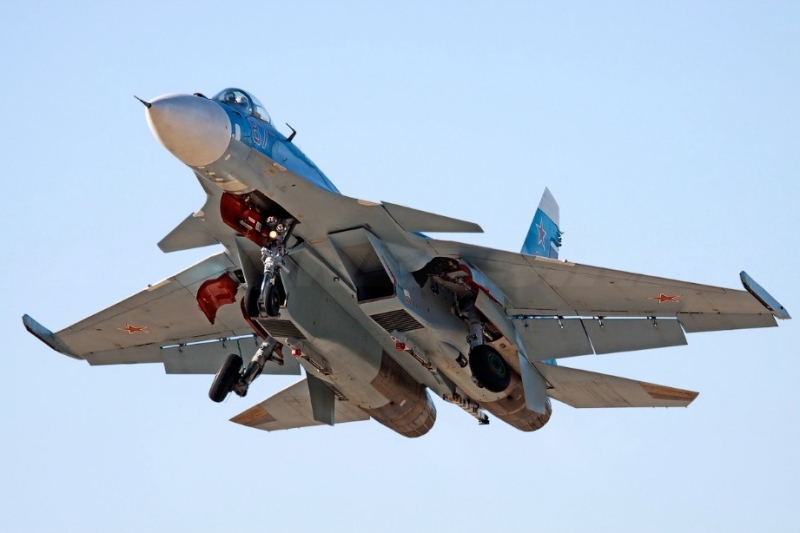
The next day was to take off from an aircraft carrier deck. The first to take off Su-25UTG, and then I went in to land, and then took off again. The Su-33 was installed on the first take-off position with a distance of the run 105 m, but once the problem was detected - gazootrazhayuschy shield installed at an angle of 60 °, which caused the reflection of hot gases in the direction of the plane was close and could damage its structure. The angle of inclination of boards was immediately changed to 45 °, but when trying to take off did not work starting zaderzhniki, with the result that the plane at full afterburner mode, stood on the deck of a ship spare 10 seconds and burned valves raised gaz baffling shield. After that, the Su-33 has been moved to a corner deck, where he had no shield and gaz baffling starting zaderzhnikov performed his first takeoff from the deck of an aircraft carrier and flew to the airfield Saki. In the future, Yu. A. Semkin and B. D. Pugachev few ups from the ship was carried out with sequential build-up take-off weight.
Flight-design tests successfully completed 22 November 1989 of the year, after which the carrier was sent for revision and Composing all the necessary equipment.
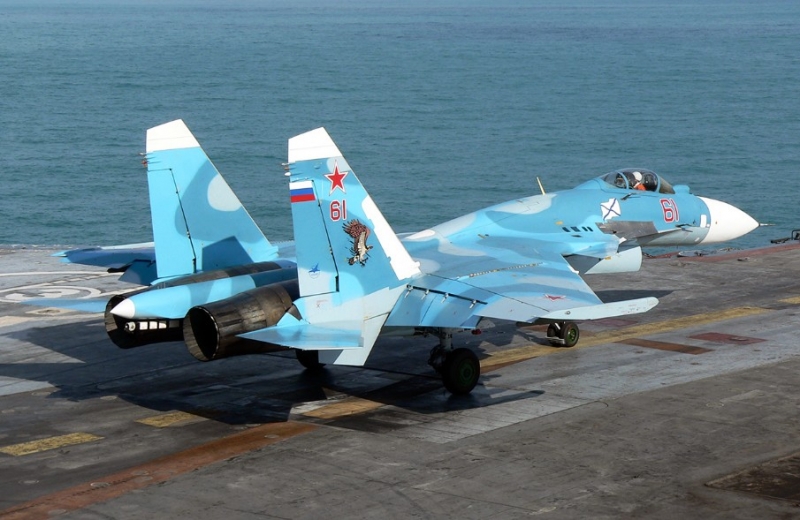
Mass production
Serial production of the Su-33 began in 1989 year KnAAPO, when the company was issued a copy of the aircraft for static tests. The first production machine (T-10K-3) It was collected at the beginning of 1990 year and 17 February of the same year, took to the air. Piloted aircraft test pilot "Sukhoi" Igor Votintsev. To end 1990 , it was built 6 Flight, all of them took part in a program of state flight tests, which began in March, 1991 of the year.
In connection with the collapse of the Soviet Union and the subsequent economic crisis, mass production of deck-based fighters Su-33 was strongly reduced. There were built 26 serial fighters, 20 of which are operated on the aircraft carrier "Admiral of the Fleet of the Soviet Union Kuznetsov". In case the Navy Command will find means volume modernzatsii Su-33 will be expanded.
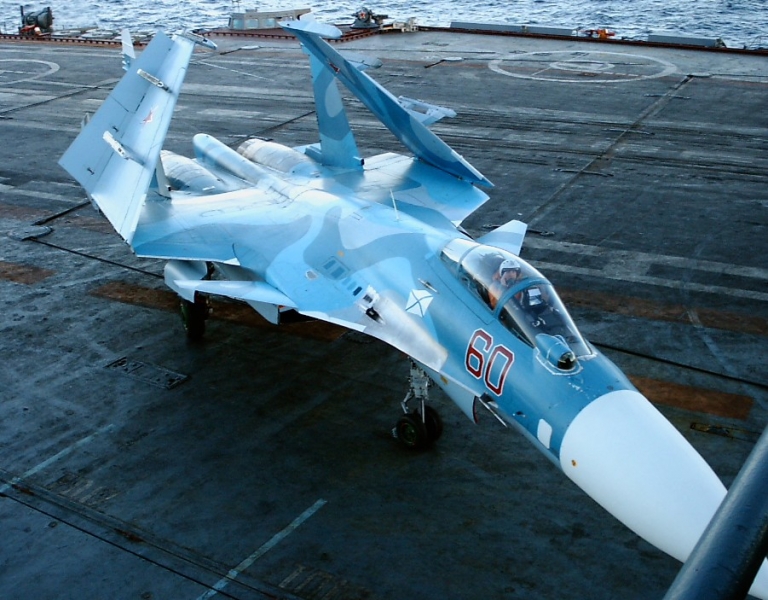
Upgrading to the Su-33M
Dry with a corporation 2002 It has been conducting repairs and upgrades to the aircraft Su-33M. Total modernization passed 19 Su-33. According to 5 October 2010 of the year, Company "Sukhoi", ground and flight tests of the modernized Su-33.
Based on the data available from the procurement of contacts to modernize, it boils down to the airplane support to act as a bomber and various modern media hanging containers for reconnaissance and target designation. Replacing the radar and support advanced missiles “air-to-air” as the PPB-AE in the plane is not made, tk. assigned role fighter MiG-29K, and the Su-33 will solve problems which require large capacity and range.
Therefore, upgrade to the Su-33M touched next:
– Upgrading or replacing with new engines to the AL-31F-M1 with a resource on 1500 takeoffs and landings
– Installation of satellite navigation GPS / GLONASS
– Installing bombing SVP-24, high-precision system
– Setting the radar warning receiver R-150
– SU-33 will be equipped with a modern system based on the MFI
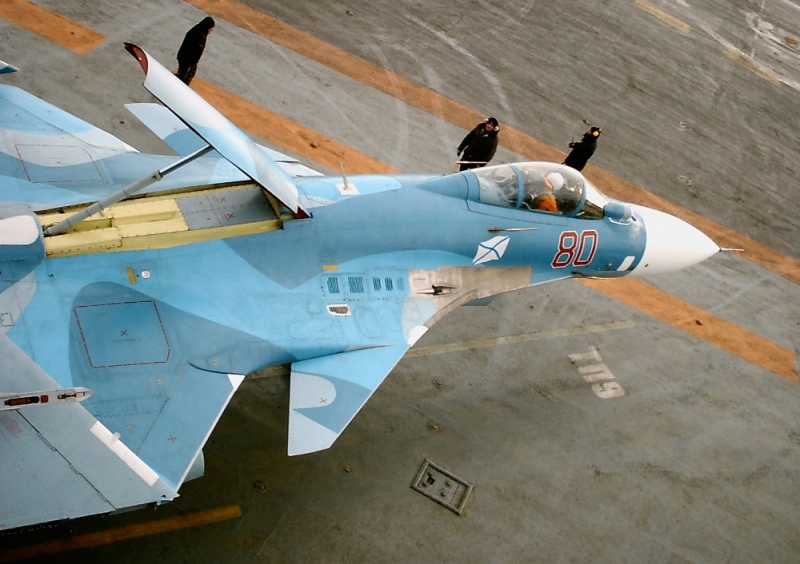
Design
Su-33 was created by normal aerodynamic scheme using canards and has an integral arrangement. trapezoidal wing, having developed nodules and smoothly mates with the fuselage, forms a single supporting body. bypass turbojet engines with afterburner are spaced nacelles, which reduces their mutual influence. Air intakes motors placed under center. Canards installed in the fade of the wing and increases both the maneuverability of the aircraft, and lifting power glider, which it is very important for the carrier-based fighter.
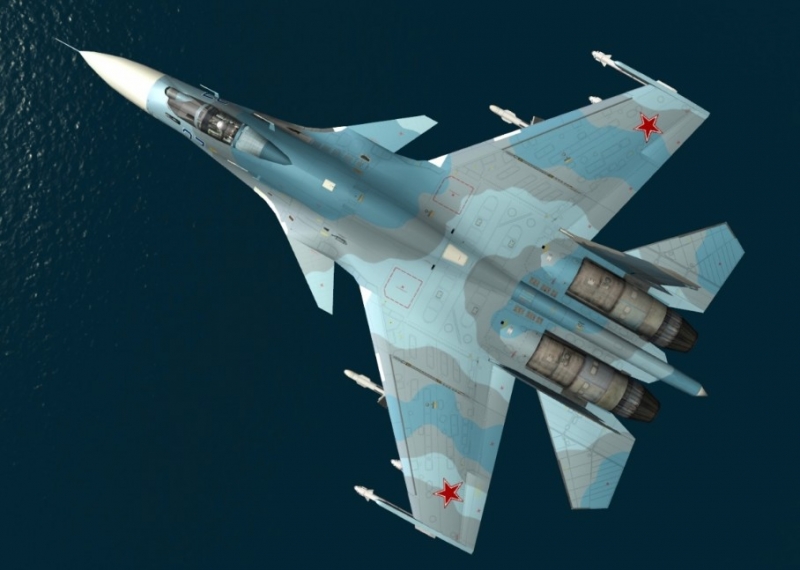
The wing and tail
Wing Su-33 performed trapezoidal, sweep of the leading edge is equal to 42,4 °, wing console recruited from profiles P44M. Area of wing 67,84 m², wingspan - 14,7 m (with suspensions of missiles or equipment on its wingtips - 14,948 m). Widely used mechanization wing, it is represented by an area flaperon 2,4 m², perform the functions of flaps and ailerons, two-section area of the flaps 6,6 m² and a toe area of the rotary trohsektsionnym 5,4 m². Tail horizontal tail consists of two differential tselnopovorotnym deviating stabilizer consoles. adjustable horizontal tail span of 9,9 m, area is 12,3 m², stabilizer profile - S9S. Canards also satisfied tselnopovorotnym. CHR sweep angle is 53,5 °, scope of consoles 6,43 m, tail area is 2,99 m². Vertical tail plane represents two trapezoidal keel with a sweep angle of the leading edge area of 40 ° and 15,1 m². Keely and Y3 have a profile fitted without collapse, each fin is equipped with a rudder area 3,49 m².
Wing folding configured fighter, that allows you to place a greater number of planes on deck and in the hangar of an aircraft carrier. Rear horizontal tail was originally performed non-folding, wherein the width of the plane was 9 m, that was on 1,2 meters more, than the competitor MiG-29K. Using emerging horizontal tail plane width has decreased to 7,4 m, that even 0,4 m less, than the MiG-29K.
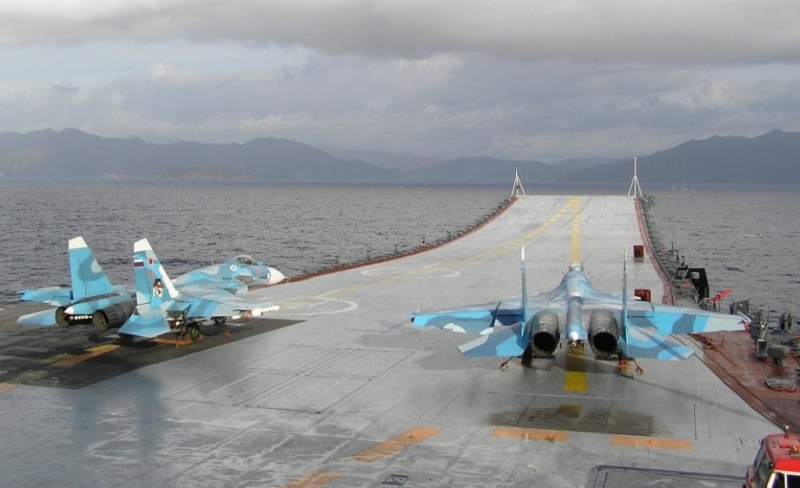
Air intakes and engines
The fighter is fitted with adjustable air inlets. The air intakes are located under the wing and fitted with influxes protective grilles, preventing ingress of foreign objects into the engine at takeoff and landing modes. Protective devices are perforated titanium panels with a large number of holes with a diameter 2,5 mm. They work in an automatic mode - lowered chassis retracting and rise to its release.
Su-33 equipped with two bypass turbojet engines with afterburner AL-31F series 3 production of "Saturn" NGO. From the base of the AL-31F engine features high up to their 12800 kgf thrust. FGUP MMPP "Salyut", engaged in the development and modernization of aircraft engines, on its official website in the modernized engine AL-31F-M1 uses photography the tail of the Su-33, which may indicate the use of these engines in this fighter. Engines AL-31F-M1 is a further development of AL-31F engine, while keeping cravings 13500 kgf, What's on 1000 kg over, than the base of the AL-31F and 700 kg over, than the AL-31F series 3. Also new engine has increased TBO and reduced fuel consumption.
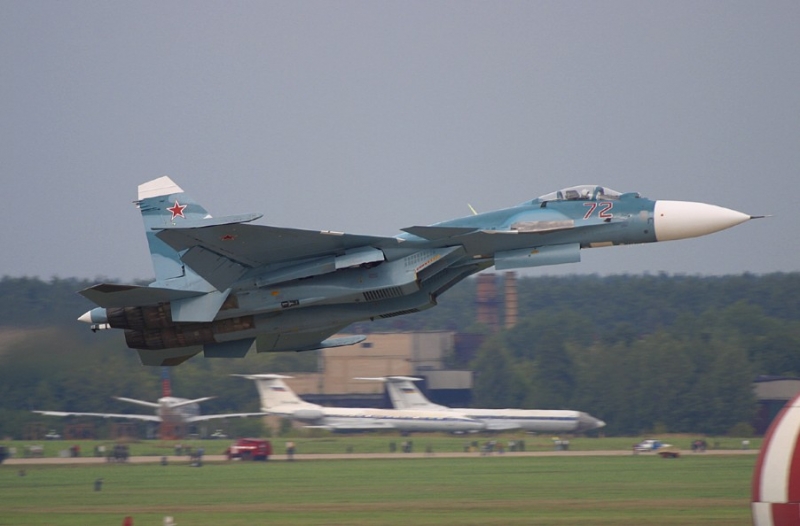
Features Su-33
While retaining all the advantages of the basic Su-27, Su-deck 33 has several features, among which:
– improved bearing properties of the wing on takeoff and landing regimes by increasing the area, application of mechanization and CHR
– increase thrust-to-weight ratio of aircraft for providing secure short take off from the deck and missed landing in the event of arrester unlinked
– amplification landing gear and landing installation hook for landing with large vertical velocities and accelerations
– installation of retractable in-flight refueling boom, Trailing possible to ORM-1K to refuel another aircraft fuel, to increase combat radius and patrol time
– use of navigation equipment for landing on the deck of an aircraft carrier
– ensuring interaction with the ship's electronic systems
– increase the number of simultaneously flown URVV to enhance aircraft combat potential in one sortie
– folding wing panels and horizontal stabilizer of the aircraft to reduce the size and increase the total number in hangars for aircraft carrier deck and
– application of corrosion protection of aircraft structures and systems for long term operation in marine climate
– ability to work effectively on surface targets
In the course of the detailed design of the Su-27 structure has suffered a number of significant changes, the most significant was the use of canards, which it was caused by the need to ensure the aircraft longitudinal static instability, that with the growth of mass radar almost 200 kg and center of mass displacement could become statically stable. As a result of testing the T-10-24 with canards revealed, that its use significantly increases the lifting force of the airframe, after which it was decided to use the CHR as an integral element of the design of all future modifications of the Su-27.
Exploitation
The plane adopted for 31 August 1998 of the year. Of 26 production vehicles 4 aircraft lost in crashes. At present, the Air Group aircraft carrier "Admiral Kuznetsov" is 10 units Su-33 from the production batch. Rest (12) based at the airport 279 separate naval fighter regiment of naval aviation of the Northern Fleet.
At the end 2013 – early 2014 the last repair and modernization 4 Su-33: at the end 2013 , two Su-33 with red hull numbers 67 and 84; and 21.2.2014 made of a pair of flight Komsomolsk-na-Severomorsk two more SU-33 with red board numbers 85 (serial number 08302) and 88 (serial number 09301).
all with 2002 , the process of renovation and modernization in Komsomolsk-on-Amur passed 19 Su-33 (including two aircraft – twice).
According to reports, at the end of February 2014 year as part of the 279th Regiment are 14 flight of Su-33, of which 8 (with onboard numbers 62, 66, 68, 76, 77, 78, 79 and 80) located in the campaign aboard the heavy aircraft carrier "Admiral of the Soviet Union Fleet Kuznetsov", a 6 (with onboard numbers 67, 84, 85, 86, 87 and 88) – on the coastal shelf airfield Severomorsk. Yet 7 SU-33 are stored in Severomorsk.
Svezheotremontirovannye red hull numbers 67, 84, 85 and 88 10 Martha 2014 for the first time income to 859 th Center of combat employment and training flight crews Naval Aviation of the Russian Navy in Yeisk.
From late summer to early September 2014 year 6 Su-33 and 2 Sioux 25UTG for a few weeks hold training flights in complex NITKA pilots separate naval fighter air regiment deck SF aviation. After returning from an airfield in the Crimea Saki airfield permanent deployment pilots continued to exercise over the Barents Sea.
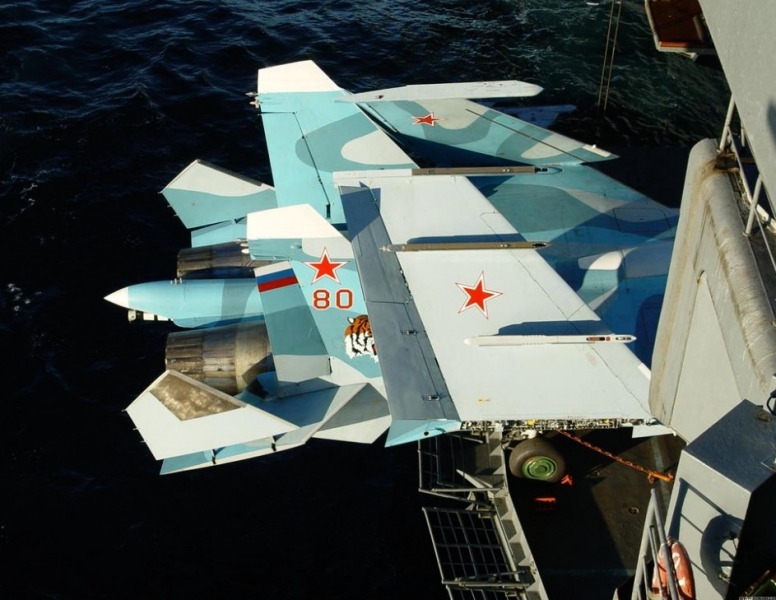
Combat application of Su-33
In November 2016, during videoconferencing Russian operations in Syria, from the deck of an aircraft carrier, the first combat use of the Su-33.Pravda as a result of a failed landing on the Admiral Kuznetsov, one of the planes crashed ,but the pilot ejected thereby saved his life and health.
Incidents of Su-33
Since its first flight of the Su-33 was 8 accident, 5 of which were caused by technical failure of the aircraft.
– 28 September 1988 , the first prototype T10K-1 (b / n 37) running a test pilot Nikolai Sadovnikov at height 2000 m and speed 1270 km / h, lost control due to hydraulic failure. pilot ejected.
– 11 July 1991 , one of the initial batch of aircraft is lost due to the failure EDSU (T10K-8). Pilot Colonel Timur Apakidze catapulted.
– 26.12.1994 Su-33 crash №net (08-05), KnAAPO lost during the scheduled test flight on KnAAPO as a result of pilot error.
– 17 June 1996 year when performing a training flight in bad weather crashed Su-33 (b / n 65) from the 1st AE 279 GIAP. He drove the car Vitaly Kuzmenko died.
– 11 May 2000 the year when the scheduled flights of a separate naval aviation regiment of the Northern Fleet crashed deck fighter Su-33 (b / n 73), piloted by the pilot of the first class Colonel Paul Kretov. The pilots managed to eject from the machine falling and land safely in approximately 54 kilometers away from the base airfield Severomorsk-3. On the plane there was a failure of the onboard control system.
– 17 July 2001 , during air show, devoted to the Day of Naval Aviation in the garrison "Island" near Pskov crashed Su-33 (b / n 70), He is driven by the Hero of Russia, Major General Timur Apakidze. After exponential filter for piloting the implementation complexity maximum figures, plane crashed and burned, pilot evacuated the rescue services, but the injuries were incompatible with life, and on the way to hospital pilot died.
– 5 September 2005 year lost a plane Su-33 (b / n 82) under the control of Lieutenant Colonel Yuri Korneev. The pilot ejected safely. The incident occurred during landing on the deck of the heavy aircraft carrier "Admiral Kuznetsov". Because of breakage of a cable arresting gear (brake) the aircraft continued to move around the deck, He fell into the sea and sank.
– 3 December 2016 year when landing on the deck of the heavy aircraft carrier "Admiral Kuznetsov" because of the arresting gear cable break the plane skidded off the deck, pilot ejected. Head of flight, who was in the control tower ship, He gave the pilot permission to land, and the latter took up the maneuver. Fighter snagged a cable hook-hook and started to reduce the engine revs. He made his way around 50 m, after which the rope broke, and, instead of stopping on the deck, Su-33 continued to move. Enable Fast and the Furious and make an attempt to call the second circle, the pilot had no time. After a few seconds the pilot to fly the head gave a command to eject, he immediately made. Himself plane crashed into the sea from the deck. As the main cause of the accident Defense Commission is considering the human factor: experts found, that a deviation of landing fighter axis has been exceeded by nearly two feet from the maximum permissible (4,7 m instead 4,2 m). Broken cable could be due to a marriage, authorized in the manufacture of, however, rejected this version of the proletarian factory (part of the United Shipbuilding Corporation), producing arresting gear runway complex “Svetlana- 2”: their representative claims, the cables, mounted on “Admiral Kuznetsov”, We went all relying test cycle, including tear. “It is important to understand the sequence: or the cable could not bear the load because of an error, made when landing, or rope broke, which led to the accident, but judging by the parameters of the aircraft at the time of landing, even completely would not survive such a defective cable load - there is piloting error”. The official representative of the Russian Defense Ministry declined to comment, promising to provide them immediately after the commission.
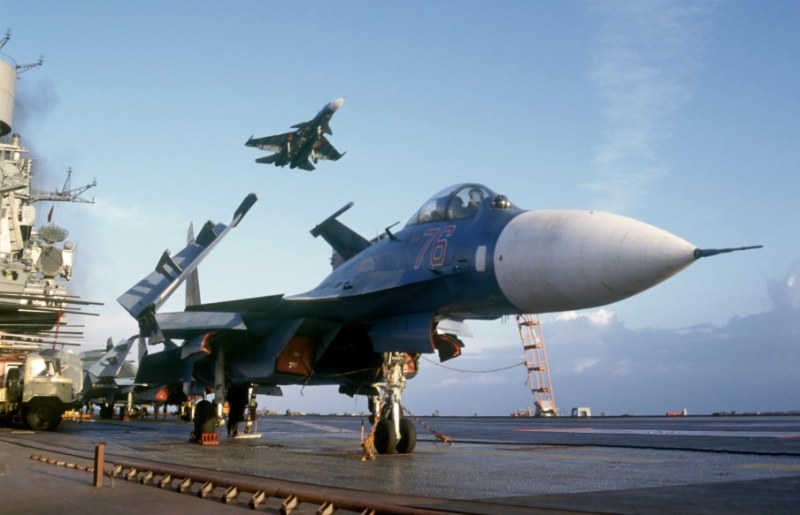
Avionics
radar: RLPK-27K
Antenna:
– A type: N001K
– Diameter: 1075 mm
keepout:
– height: ±50°
– azimuth: ±60°
Detection range of aerial target with EPR = 3 m²:
– to meet: 100 km
– vdogon: 40 km
Number of simultaneously tracked targets: 10
OES: OEPS-27K
A type: Rope-27K ("46SH")
keepout:
– height: -15°/+60°
– azimuth: ±60°
field of View: 120×75°
viewing angle: 60×10°, 20×5°, 3×3°
Range tracking aerial target teplokontrastnoy:
– to meet: 40 km
– vdogon: 100 km
The range of measured distances: 6 km
Nashlemnaya reconnaissance system:"The slit-3UM-1"
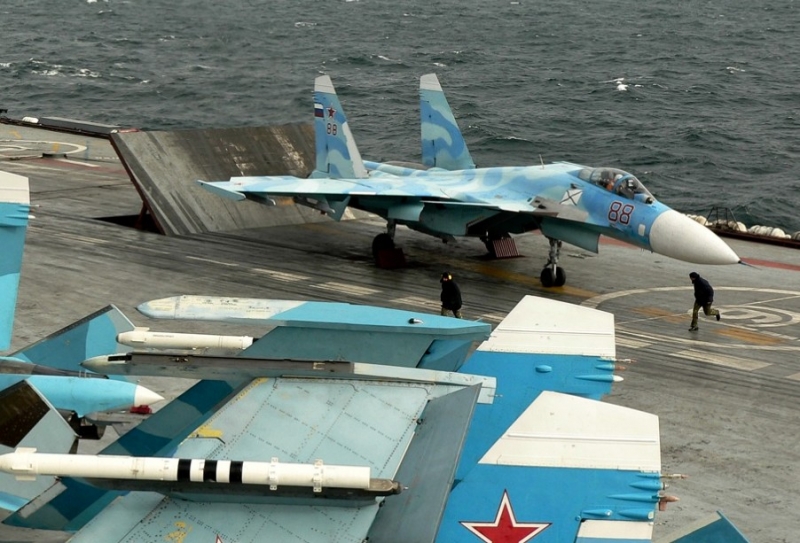
Weapon Su-33
– cannon: 1 × 30 mm cannon GS-30-1 (ʙoezapas 150 shells)
Combat load Su-33
– maximum: 6500 kg
– variant B-B: 3200 kg (8 × P or 27Э 6 × R-73)
– Nodes suspension arms: 10
air-to-SU-33 guided missiles
– 2 × R-73
– 4-6 × R-27R / ER
– 2 × P-27T / ET
Guided missiles, air-to-ground of the Su-33
– X-41 "Mosquito"
– P-800 "Onyx"
Rockets Su-33
– 80 (4 × 20) × 80 mm 8KOM C / C-8BM in blocks B-8M1 or
– 20 (4 × 5) × 122 mm C-13T in blocks B-13L or
– 4 × 266 mm C-25-RPM-PU
Bomby Su-33
– 8 × 500 kg (FAB-500, RBK-500, BZ-500) or
– 28 × 250 kg (FAB-250, RBC and 250 m. d.) or
– 32 × 100 kg
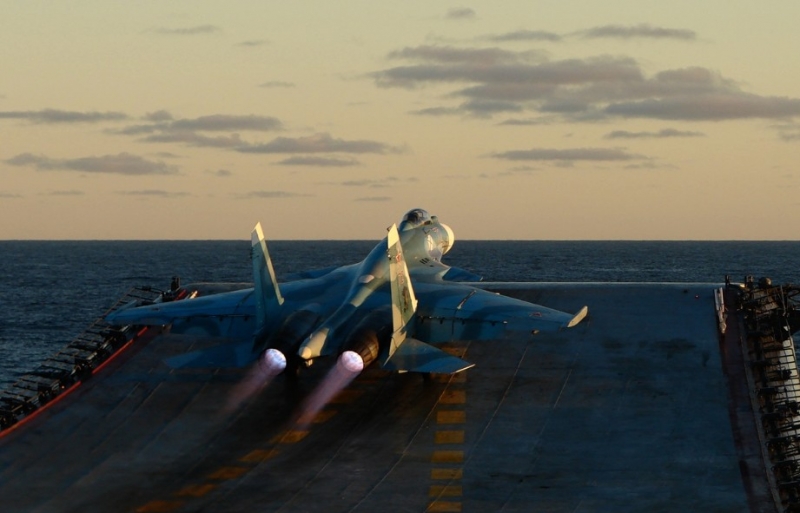
Tactic-technical characteristics of the Su-33
The crew of the Su-33
– 1 human
The dimensions of the Su-33
– Length: 21,18 m
Wingspan: 14,7 m
– with folded wings: 7,40 m
– with suspended missiles on wingtips: 14,948 m
Swipe back GO: 9,9 m
– with folded stabilizers: 7,40 m
– Height: 5,72 m
– wing area: 67,84 m²
– airfoil: P44M
– Ratio Wing elongation: 3,48
– Ratio Wing constriction: 3,76
– Sweep angle of the leading edge: 42,5°
– The base chassis: 5,87 m
– track chassis: 4,44 m
All Su-33
– empty weight: 19600 kg
– Curb weight: 20440 kg (2 × P 27Э + 2 × R-73)
– Mass normal takeoff with partial filling: 26000 kg
– Weight normal takeoff with full fuel: 29940 kg
– Weight maximum takeoff: 33000 kg
– fuel weight 9400 kg; basic embodiment refueling 5350 kg
– Normal landing weight: 22400 kg
– Landing weight limit: 26000 kg
– Volume of fuel tanks: 12100 l
Engine Su-33
– engine's type: Turbofan with afterburner
– model: "AL-31F series 3"
– bypass ratio: 0,571
– engine weight: 1520 kg
Taga Su-33
– maximum: 2 × 7670 kgf (74,5 kN)
– Furious at: 2 × 12500 kgf (122,6 kN)
– emergency mode: 2 × 12800 kgf (125,5 kN)
The rate of the Su-33
– Maximum speed at height: 2300 kmh (M = 2.17)
– Maximum speed at ground: 1300 kmh (M = 1.09)
Landing speed Su-33
– 235-250 km / h
Range of flight of Su-33
– near the ground: 1000 km
– on high: 3000 km
– Duration patrols away 250 km: 2 no
Practical ceiling Su-33
– 17000 m
Afterburner thrust-to-weight ratio on the Su-33
– during normal takeoff weight with partial filling: 0,96
– during normal takeoff weight with complete dressing: 0,84
– at maximum takeoff weight: 0,76
Takeoff run Su-33
– 105 m (with springboard)
Length PROBE Su-33
– 90 m (with arresting gear)
Maximum overload of Su-33
8,5 g (or 8)
Photo Su-33
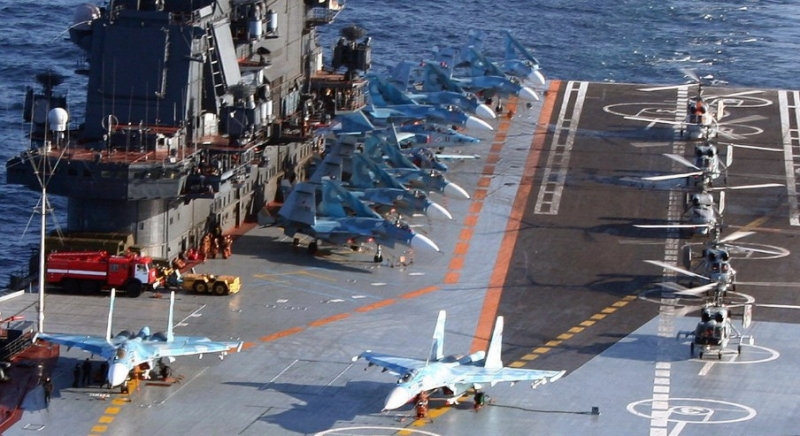
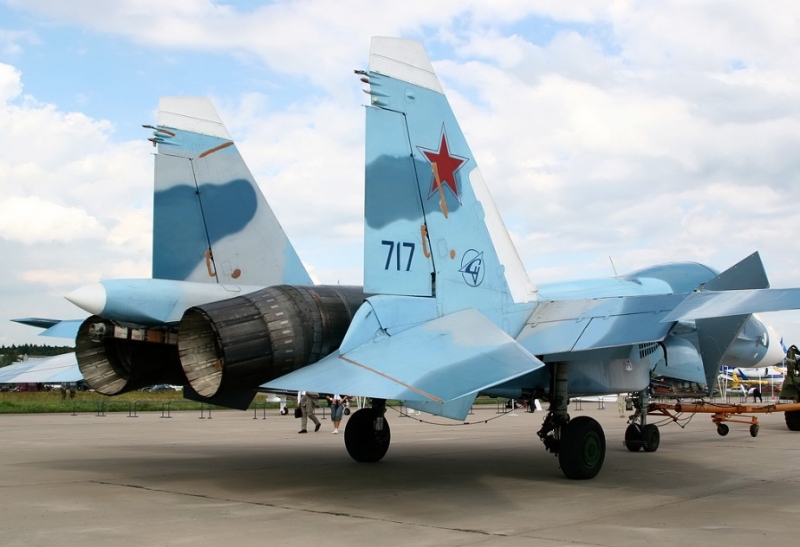
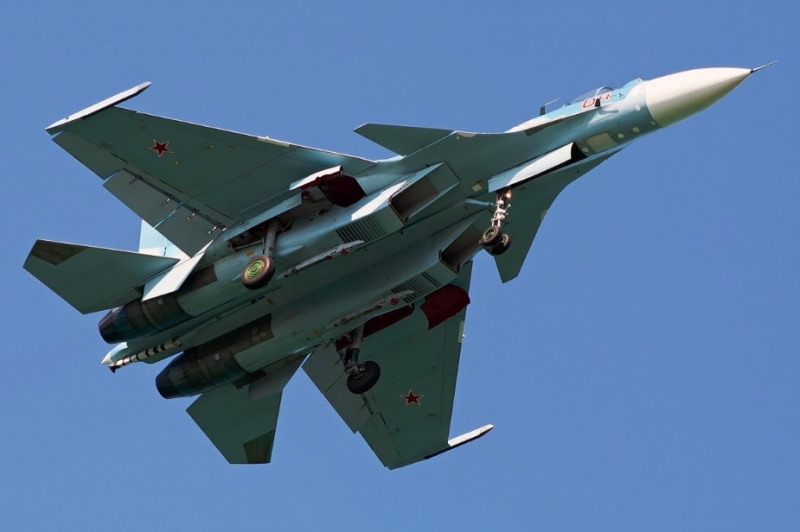
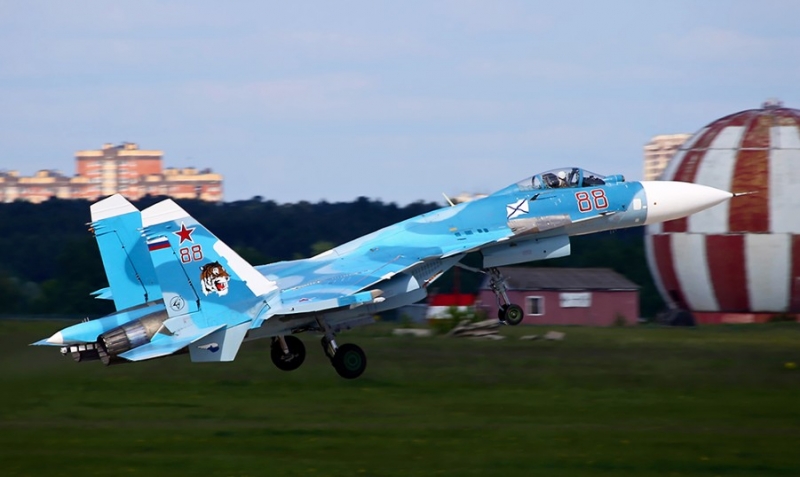
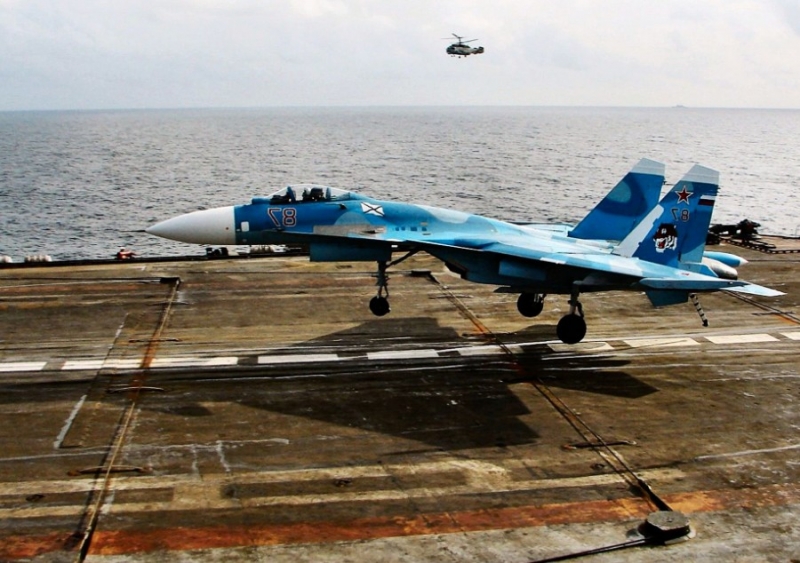
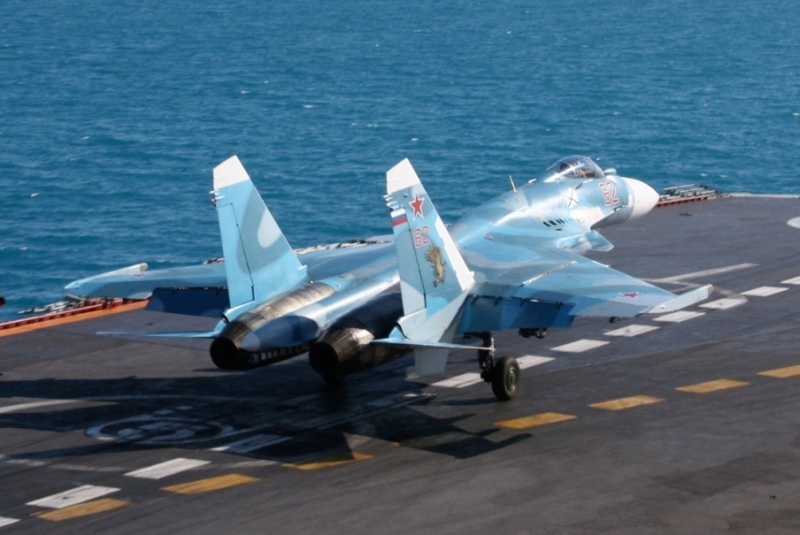
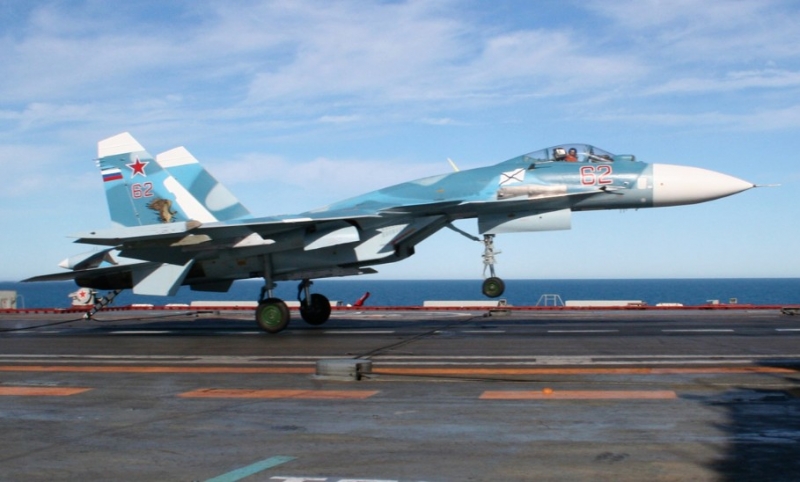
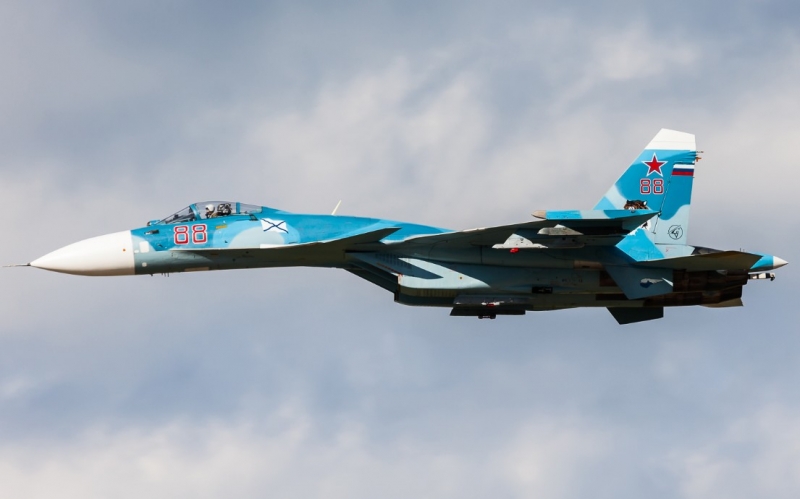
Cabin Su-33
